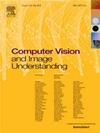曼荼罗简化:神圣的对称遇上极简主义
IF 4.3
3区 计算机科学
Q2 COMPUTER SCIENCE, ARTIFICIAL INTELLIGENCE
引用次数: 0
摘要
曼陀罗,具有径向对称的复杂艺术设计,充满了超越文化界限的永恒魅力。曼荼罗在世界各地的各种文化和精神传统中都有发现,作为团结、完整和精神转化的象征,曼荼罗具有深远的意义。曼荼罗的核心是神圣对称的概念,这是一个永恒的原则,与人类意识的最深处产生共鸣。然而,在手工制作的曼陀罗中,对称往往不够完美,需要改进以唤起和谐与平衡。考虑到这一点,我们引入了一种计算方法,旨在通过极简原则捕捉曼陀罗的全方位对称性。通过利用创新的几何和图论工具以及交互式双地图集,这种方法简化了参数域,以实现神圣对称的崇敬状态,体现了和谐的平衡。当处理手工制作的低质量的曼荼罗时,这是特别有益的,需要简洁的表示来完成像曼荼罗编辑、娱乐、地图集构建和参考这样的任务。实验结果和相关结果证明了所提出方法的有效性。本文章由计算机程序翻译,如有差异,请以英文原文为准。

Mandala simplification: Sacred symmetry meets minimalism
Mandalas, intricate artistic designs with radial symmetry, are imbued with a timeless allure that transcends cultural boundaries. Found in various cultures and spiritual traditions worldwide, mandalas hold profound significance as symbols of unity, wholeness, and spiritual transformation. At the heart of mandalas lies the concept of sacred symmetry, a timeless principle that resonates with the deepest realms of human consciousness. However, in handcrafted mandalas, symmetry often falls short of perfection, necessitating refinement to evoke harmony and balance. With this in mind, we introduce a computational approach aimed at capturing the all-round symmetry of mandalas through minimalist principles. By leveraging innovative geometric and graph-theoretic tools and an interactive twin atlas, this approach streamlines parameter domains to achieve the revered state of sacred symmetry, epitomizing harmonious balance. This is especially beneficial when dealing with handcrafted mandalas of subpar quality, necessitating concise representations for tasks like mandala editing, recreation, atlas building, and referencing. Experimental findings and related results demonstrate the effectiveness of the proposed methodology.
求助全文
通过发布文献求助,成功后即可免费获取论文全文。
去求助
来源期刊

Computer Vision and Image Understanding
工程技术-工程:电子与电气
CiteScore
7.80
自引率
4.40%
发文量
112
审稿时长
79 days
期刊介绍:
The central focus of this journal is the computer analysis of pictorial information. Computer Vision and Image Understanding publishes papers covering all aspects of image analysis from the low-level, iconic processes of early vision to the high-level, symbolic processes of recognition and interpretation. A wide range of topics in the image understanding area is covered, including papers offering insights that differ from predominant views.
Research Areas Include:
• Theory
• Early vision
• Data structures and representations
• Shape
• Range
• Motion
• Matching and recognition
• Architecture and languages
• Vision systems
 求助内容:
求助内容: 应助结果提醒方式:
应助结果提醒方式:


